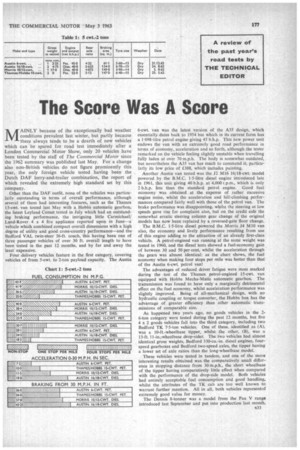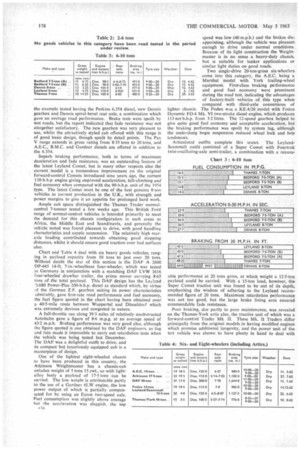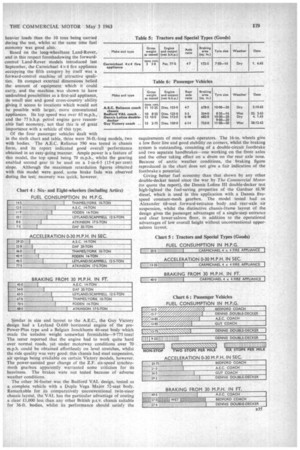The Score Was A Score
Page 179

Page 180

Page 181

If you've noticed an error in this article please click here to report it so we can fix it.
MAINLY because of the exceptionally bad weather conditions prevalent last winter, but partly because there always tends to be a dearth of new vehicles which can be spared for road test immediately after a London Commercial Motor Show, only 20 vehicles have been tested by the staff of The Commercial Motor since the 1962 summary was published last May. For a change also non-British vehicles do not figure prominently this year, the only foreign vehicle tested having been the Dutch DAF lorry-andrtrailer combination, the report of which revealed the extremely high standard set by this company.
Other than the DAF outfit, none of the vehicles was particularly outstanding in terms of overall performance, although several of them had interesting features, such as the Thames 15-cwt. van tested last May with a Hobbs automatic gearbox, the latest Leyland Comet tested in July which had an outstanding braking performance, the intriguing little Carmichael/ Land-Rover 4 x 4 fire appliance reported upon in June-a vehicle which combined compact overall dimensions with a high degree of utility and good cross-country performance-and the Bedford VAL twin-steer 36-ft. coach, this having been one of three passenger vehicles of over 30 ft. overall length to have been tested in the past 12 months, and by far and away the least expensive.
Four delivery vehicles feature in the first category, covering vehicles of from 5-cwt. to 2-ton payload capacity. The Austin 6-cwt, van was the latest version of the A35 design, which essentially dates back to 1954 but which in its current form has a 1.098-litre petrol engine giving 45 b.h.p. This new power unit endows the van with an extremely good road performance in terms of economy, acceleration and so forth, although the tester remarked on the vehicle feeling slightly unstable when travelling fully laden at over 70 m.p.h. The body is somewhat outdated, but nevertheless the A35 van has much to commend it, particularly its low price of £388, which includes painting.
Another Austin van tested was the J2 M16 16/18-cwt. model powered by the B.M.C. 1.5-litre diesel engine introduced late in 1961, this unit giving 40 b.h.p. at 4,000 r.p.m., which is only 2 b.h.p. less than the standard petrol engine. Good fuel economy was obtained at the expense of rather excessive engine noise, whilst the acceleration and hill-climbing performances compared fairly well with those of the petrol van. The brake performance was disappointing, whilst the steering at low speeds gave rise for complaint also, but on the credit side the somewhat erratic steering column gear change of the original models has now been replaced by a reversed-gate floor change.
The B.M.C. 1.5-Iitre diesel powered the Morris J4 MIO van also, the economy and lively performance resulting from use of this engine adding to the attraction of an already first-class vehicle. A petrol-engined van running at the same weight was tested in 1960, and the diesel tests showed a fuel-economy gain of between 30 and 50 per cent, whilst the acceleration through the gears was almost identical: as the chart shows, the fuel economy when making four stops per mile was better than that of the Austin 6-cwt. petrol van!
The advantages of reduced driver fatigue were most marked during the test of the Thames petrol-engined 15-cwt. van equipped with Hobbs Mecha-Matic automatic gearbox. The transmission was found to have only a marginally detrimental effect on the fuel economy, whilst acceleration performance was slightly improved. Being of all-mechanical design, with no hydraulic coupling or torque converter, the Hobbs box has the advantage of greater efficiency than other automatic transmissions of comparable size.
As happened two years ago, no goods vehicles in the 26-ton category were tested during the past 12 months, but five 4 x 2 goods vehicles fall into the third category, including two Bedford TK 7-5-ton vehicles. One of these, identified as (A), was a 10-ft.-wheelbase tipper, whilst the other, (B), was a 13-ft. 11-in,rwheelbase drop-sider. The two vehicles had almost identical gross weights, Bedford 330-cu.-in, diesel engines, fourspeed gearboxes and Redford two-speed axles, the tipper having a lower set of axle ratios than the long-wheelbase model.
These vehicles were tested in tandem, and one of the more interesting results obtained was the comparatively small difference in stopping distance from 30 m.p.h., the short wheelbase of the tipper having comparatively little effect when compared with the performance of the drop-side model. Both vehicles had entirely acceptable fuel consumption and good handling, whilst the attributes of the TK cab are too well known to warrant further mention. All in all, both vehicles represented extremely good value for money.
The Dennis 8-tonner was a model from the Pax V range introduced last September and put into production last month, 1333
the example tested having the Perkins 6.354 diesel, new Dennis gearbox and Dennis spiral-bevel rear axle, a combination which gave an average road performance. Brake tests were spoilt by wet roads, but the report indicated that fade resistance was not altogether satisfactory. The new gearbox was very pleasant to use, whilst the attractively styled cab offered with this range is of good basic design, though spoilt by detail points. The Pax V range extends in gross rating from 8.35 tons to 20 tons, and A.E.C., B.M.C. and Gardner diesels are offered in addition to the 6.354.
Superb braking performance, both in terms of maximum decelerat:on and fade resistance, was an outstanding feature of the latest Leyland Comet, but in many other respects also the current model is a tremendous improvement on the original forward-control Comets introduced nine years ago, the current 110-b.h.p. engine giving improved acceleration, hill-climbing and fuel economy when compared with the 90-b.h.p. unit of the 1954
type. The latest Comet must he one of the best genuine 8-ton vehicles in current production in the U.K., with strength and
power margins to give it an appetite for prolonged hard work.
Ample cab space distinguished the Thames Trader normalcontrol 7-tonner tested a few weeks ago. This British Ford
range of normal-control vehicles is intended primarily to meet the demand for this chassis configuration in such areas as Africa, the Middle East and Scandinavia, and generally the vehicle tested was found pleasant to drive, with good handling characteristics and supple suspension. The relatively high rearasle loading contributed towards obtaining good stopping distances, whilst it should ensure good traction over had surfaces also.
Chart and Table 4 deal with six heavy goods vehicles, ranging in payload capacity from 10 tons to just over 20 tons.
Without doubt the star of this section is the DAF A 2600 DP-445 14-ft. 7-in.-wheelbase four-wheeler, which was tested in Germany in conjunction with a matching DAF LVW 1616
four-wheeled drawbar trailer, the prime mover carrying 8-65
tons of the total payload. This DAF design has the Leyland '1680 Power-Plus 200-b.h.p. diesel as standard which, by virtue
of the German Z.F. gearbox suiting its power characteristics idmirably, gave first-rate road performance and fuel economy, the fuel figure quoted in the chart having been obtained over a 40-5-mile route between Wuppertal and Dusseldorf which was extremely devious and congested in nature.
A full-throttle run along 39.3 miles of relatively unobstructed Autobahn gave a figure of 8.6 m.p.g. at an average speed of
43.2 m.p.h. Braking performance was very good also, although thc figure quoted is one obtained by the DAF engineers, as fog and rain made it impossible to carry out retardation tests when the vehicle was being tested last December. The DAF was a delightful outfit to drive, and its compact but luxuriously equipped cab is a masterpiece of design.
One of the lightest eight-wheeled chassis to have been produced in this country, the Atkinson Weightmaster has a chassis-cab unladen weight of 5 tons 15 cwt., so with lightalloy body a payload of 17.5 tons can be carried. The low weight is attributable partly to the use of a Gardner 6LW engine, the low power output of which is partially compen sated for by using an Eaton two-speed axle. Fuel consumption was slightly above average but the acce!eration was sluggish, the top
speed was low (40 m.p.h.) and the brakes disappointing, although the vehicle was pleasant enough to drive under normal conditions. Because of its light construction the Weightmaster is in no sense a heavy-duty chassis, but is suitable for tanker applications or similar light duties on good roads.
Two single-drive 20-ton-gross six-wheelers come into this category, the A.E.C. being a Marshal model with York trailing-wheel equipment. First-class braking performance and good fuel economy were prominent during the road test, indicating the advantages of factory-built vehicles of •this type when compared with third-axle conversions of lighter chassis. The Foden was a KE.4/20 model with Foden Dynamic FD.4 Mk. VI two-stroke diesel engine, which produces 113 net b.h.p. from 3.2 litres. The 12-speed gearbox helped to give quite good fuel economy and acceptable acceleration, but the braking performance was spoilt by system lag, although the underslung bogie suspension reduced wheel lock and hop tendencies.
Articulated outfits complete this sextet. The LeylandSeammell outfit consisted of a Super Comet with Fourtrak twin-oscillating-axle semi-trailer, a combination with a reason
Date
Dry 15, 6.62.
Dry 15 6.62
Wet
12, 4.63 Dry 6. 7.62 Dry 29. 3.63
able performance at 20 tons gross, at which weight a 12.5-ton payload could be carried. With a 15-ton load, however, the Super Comet tractive unit was found to be out of its depth, emphasising the wisdom of adhering to the Leyland recommended figure of 20 tons. Maximum retardation performance was not too good, but the large brake lining area ensured commendable fade resistance.
Poor braking, due partly to poor maintenance, was revealed on the Thames-York artic also, the tractive unit of which was a forward-control Trader Mk IL These Mk. 11 Traders differ principally from the original models in having modified engines which promise additienal longevity, and the power unit of the test vehicle was shown to have plenty in hand to deal with
heavier loads than the 10 tons being carried during the test, whilst at the same time fuel economy was good also.
Based on the long-wheelbase Land-Rover, and in this respect foreshadowing the forwardcontrol Land-Rover models introduced last September, the Carmichael 4x4 fire appliance occupying the fifth category by itself was a forward-control machine of attractive qualities. Its compact external dimensions belied the amount of equipment which it could carry, and the machine was shown to have undoubted possibilities as a first-aid appliance, its small size and good cross-country ability giving it access to locations which would not be possible with larger, more conventional appliances. Its top speed was over 65 m.p.h., and the 77 b.h.p. petrol engine gave reasonable fuel economy, not that this is of great importance with a vehicle of this type.
Of the four passenger vehicles dealt with in the sixth chart and table, three were 36-ft,-long models, two with bodies. The A.E.C. Reliance 590 was tested in chassis form, and its report indicated good overall performance obtained in an easy-going manner. Ample power is a feature of this model, the top speed being 70 m.p.h., whilst the gearing enabled second gear to be used on a I-in-6.5 (154 per cent) slope. Although the maximum retardation figures obtained with this model were good, some brake fade was observed during the test; recovery was quick, however.
Similar in size and layout to the A.E.C., the Guy Victory design had a Leyland 0.680 horizontal engine of the prePower-Plus type and a Belgian Ionckheere 46-seat body which made the unladen weight somewhat formidable-9-775 tons! The tester reported that the engine had to work quite hard over normal roads, yet under motorway conditions over 70 m.p.h. could be obtained effortlessly on level stretches, whilst the ride quality was very good: this chassis had steel suspension, air springs being available on certain Victory models, however_ The power-assisted gear change of the Z.F. six-speed synchromesh gearbox apparently warranted some criticism for its heaviness. The brakes were not tested because of adverse weather conditions.
The other 36-footer was the Bedford VAL design, tested as a complete vehicle with a Duple Vega Major 52-scat body. Remarkable for its comparatively unconventional twin-steer chassis layout, the VAL has the particular advantage of costing a clear £1,000 less than any other British p.s.v. chassis suitable for 36-ft. bodies, whilst its performance should satisfy the requirements of most coach operators. The 16-in, wheels give a low floor line and good stability on corners, whilst the braking system is outstanding, consisting of a double-circuit footbrake and two separate handbrakes—one working on the front axles and the other taking effect on a drum on the rear axle nose. Because of arctic weather conditions, the braking figure reproduced in the chart does not give a fair indication of the footbrake s potential.
Giving better fuel economy than that shown by any other double-decker tested since the war by The Commercial Motor (to quote the report), the Dennis Loline III double-decker test high-lighted the fuel-saving properties of the Gardner 6LW diesel, which is used in this application with a Dennis Byespeed constant-mesh gearbox. The model tested had an Alexander 68-seat forward-entrance body and rear-axle air suspension, whilst the distinctive chassis.frame layout of the design gives the passenger advantages of a single-step entrance and clear lower-saloon floor, in addition to the operational advantages of low overall height without unconventional uppersaloon layout.




















































































































































































































































